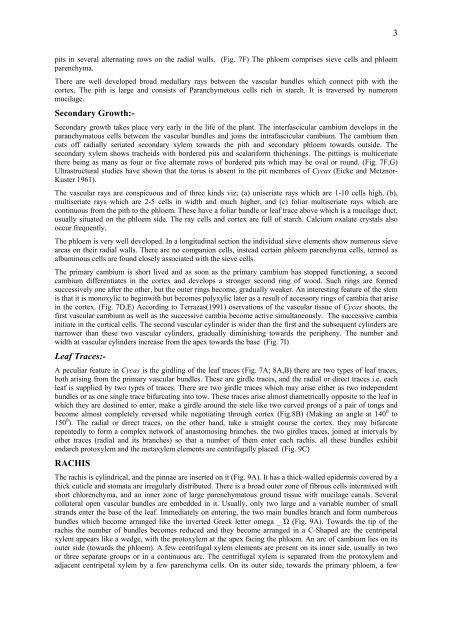Diversity of seed plants and their systematics
Diversity of seed plants and their systematics
Diversity of seed plants and their systematics
You also want an ePaper? Increase the reach of your titles
YUMPU automatically turns print PDFs into web optimized ePapers that Google loves.
pits in several alternating rows on the radial walls. (Fig. 7F) The phloem comprises sieve cells <strong>and</strong> phloem<br />
parenchyma.<br />
There are well developed broad medullary rays between the vascular bundles which connect pith with the<br />
cortex. The pith is large <strong>and</strong> consists <strong>of</strong> Paranchymetous cells rich in starch. It is traversed by numerom<br />
mucilage.<br />
Secondary Growth:-<br />
Secondary growth takes place very early in the life <strong>of</strong> the plant. The interfascicular cambium develops in the<br />
paranchymatous cells between the vascular bundles <strong>and</strong> joins the intrafascicular cambium. The cambium then<br />
cuts <strong>of</strong>f radially seriated secondary xylem towards the pith <strong>and</strong> secondary phloem towards outside. The<br />
secondary xylem shows tracheids with bordered pits <strong>and</strong> scalariform thichenings. The pittings is multiceriate<br />
there being as many as four or five alternate rows <strong>of</strong> bordered pits which may be oval or round. (Fig. 7F,G)<br />
Ultrastructural studies have shown that the torus is absent in the pit memberes <strong>of</strong> Cycas (Eicke <strong>and</strong> Metznor-<br />
Kuster 1961).<br />
The vascular rays are conspicuous <strong>and</strong> <strong>of</strong> three kinds viz; (a) uniseriate rays which are 1-10 cells high, (b),<br />
multiseriate rays which are 2-5 cells in width <strong>and</strong> much higher, <strong>and</strong> (c) foliar multiseriate rays which are<br />
continuous from the pith to the phloem. These have a foliar bundle or leaf trace above which is a mucilage duct,<br />
usually situated on the phloem side. The ray cells <strong>and</strong> cortex are full <strong>of</strong> starch. Calcium oxalate crystals also<br />
occur frequently.<br />
The phloem is very well developed. In a longitudinal section the individual sieve elements show numerous sieve<br />
areas on <strong>their</strong> radial walls. There are no companion cells, instead certain phloem parenchyma cells, termed as<br />
albuminous cells are found closely associated with the sieve cells.<br />
The primary cambium is short lived <strong>and</strong> as soon as the primary cambium has stopped functioning, a second<br />
cambium differentiates in the cortex <strong>and</strong> develops a stronger second ring <strong>of</strong> wood. Such rings are formed<br />
successively one after the other, but the outer rings become, gradually weaker. An interesting feature <strong>of</strong> the stem<br />
is that it is monoxylic to beginwith but becomes polyxylic later as a result <strong>of</strong> accessory rings <strong>of</strong> cambia that arise<br />
in the cortex. (Fig. 7D,E) According to Terrazas(1991) oservations <strong>of</strong> the vascular tissue <strong>of</strong> Cycas shoots, the<br />
first vascular cambium as well as the successive cambia become active simultaneously. The successive cambia<br />
initiate in the cortical cells. The second vascular cylinder is wider than the first <strong>and</strong> the subsequent cylinders are<br />
narrower than these two vascular cylinders, gradually diminishing towards the peripheny. The number <strong>and</strong><br />
width at vascular cylinders increase from the apex towards the base (Fig. 7I)<br />
Leaf Traces:-<br />
A peculiar feature in Cycas is the girdling <strong>of</strong> the leaf traces (Fig. 7A; 8A,B) there are two types <strong>of</strong> leaf traces,<br />
both arising from the primary vascular bundles. These are girdle traces, <strong>and</strong> the radial or direct traces i.e. each<br />
leaf is supplied by two types <strong>of</strong> traces. There are two girdle traces which may arise either as two independent<br />
bundles or as one single trace bifurcating into tow. These traces arise almost diametrically opposite to the leaf in<br />
which they are destined to enter, make a girdle around the stele like two curved prongs <strong>of</strong> a pair <strong>of</strong> tongs <strong>and</strong><br />
become almost completely reversed while negotiating through cortex (Fig.8B) (Making an angle at 140 0 to<br />
150 0 ). The radial or direct traces, on the other h<strong>and</strong>, take a straight course the cortex. they may bifurcate<br />
repeatedly to form a complex network <strong>of</strong> anastomosing branches. the two girdles traces, joined at intervals by<br />
other traces (radial <strong>and</strong> its branches) so that a number <strong>of</strong> them enter each rachis. all these bundles exhibit<br />
endarch protoxylem <strong>and</strong> the metaxylem elements are centrifugally placed. (Fig. 9C)<br />
RACHIS<br />
The rachis is cylindrical, <strong>and</strong> the pinnae are inserted on it (Fig. 9A). It has a thick-walled epidermis covered by a<br />
thick cuticle <strong>and</strong> stomata are irregularly distributed. There is a broad outer zone <strong>of</strong> fibrous cells intermixed with<br />
short chlorenchyma, <strong>and</strong> an inner zone <strong>of</strong> large parenchymatous ground tissue with mucilage canals. Several<br />
collateral open vascular bundles are embedded in it. Usually, only two large <strong>and</strong> a variable number <strong>of</strong> small<br />
str<strong>and</strong>s enter the base <strong>of</strong> the leaf. Immediately on entering, the two main bundles branch <strong>and</strong> form numberous<br />
bundles which become arranged like the inverted Greek letter omega _ ۟Ώ (Fig. 9A). Towards the tip <strong>of</strong> the<br />
rachis the number <strong>of</strong> bundles becomes reduced <strong>and</strong> they become arranged in a C-Shaped arc the centripetal<br />
xylem appears like a wedge, with the protoxylem at the apex facing the phloem. An arc <strong>of</strong> cambium lies on its<br />
outer side (towards the phloem). A few centrifugal xylem elements are present on its inner side, usually in two<br />
or three separate groups or in a continuous arc. The centrifugal xylem is separated from the protoxylem <strong>and</strong><br />
adjacent centripetal xylem by a few parenchyma cells. On its outer side, towards the primary phloem, a few<br />
3

















